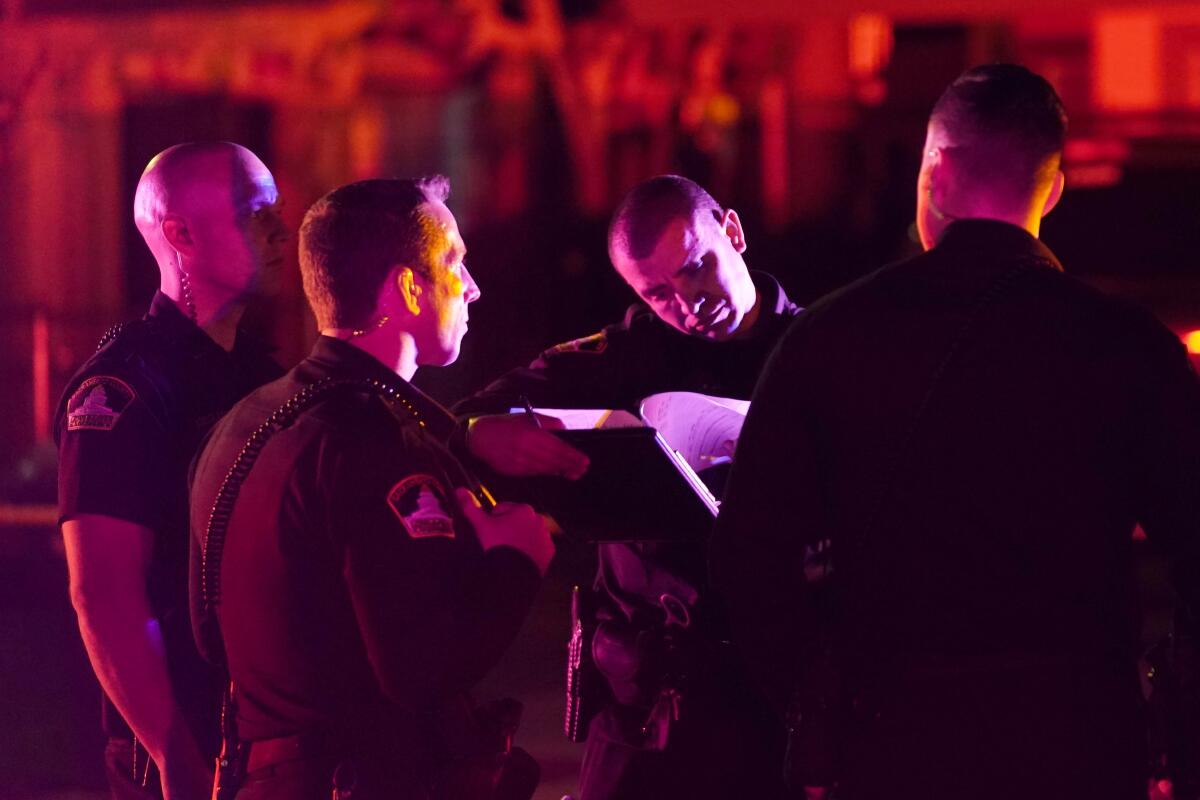Horrific killings in Sacramento-area church underscore harsh reality of domestic violence cases

- Share via
Good morning, and welcome to the Essential California newsletter. It’s Tuesday, March 8. I’m Justin Ray.
Last week, a horrific shooting took place at a Sacramento-area church.
A 39-year-old man killed his three children and a person assigned by the court to supervise his visits with the kids. Since the tragedy, details about the man behind the massacre have emerged.
Only a week before the killings, David Mora — who took his own life after the attack — assaulted a California Highway Patrol officer after driving drunk and crashing his car in a muddy field. After that incident, he remained so combative that he was also booked for assaulting an emergency room technician at a hospital. Some 11 months earlier, Mora had been placed on a psychiatric hold by Sacramento County authorities after he became aggressive and threatened to end his life.
There remains one big question about the case: How did Mora get the weapon used in the shooting? Authorities have not yet provided an answer.
Sacramento County court records show that Illeana Gutierrez Rios filed for a domestic violence restraining order in May against Mora, her then-boyfriend. The court granted the order for five years and allowed a mutual friend and member of the church, identified as 59-year-old Nathaniel Kong, to serve as chaperone for Mora’s supervised visits with the couple’s kids, Samia Mora Gutierrez, 13, Samantha Mora Gutierrez, 11, and Samarah Mora Gutierrez, 9. As part of the order, Mora was required to attest that he did not possess any guns, but as is normal, police were not directed to ensure his statement was truthful.
“Restraining order gun restrictions are an honors system,” Faith Whitmore, chief executive of the Sacramento Regional Family Justice Center, previously told The Times. “We rely on the perpetrator of violent acts to be truthful and not possess weapons. There is no follow-up, no check by law enforcement. That is something that needs to change.”
California’s “Red Flag Law”
In 2016, California became one of the first states to establish a gun confiscation law known as a “red flag law.” It allows individuals to seek a gun violence restraining order (GVRO), which allows law enforcement to remove firearms from someone who is a threat to themselves or others.
People who can request a GVRO against a person deemed a threat include family members, current or recent residents of their household, employers, co-workers and teachers.
In the case of the church massacre, Illeana Gutierrez Rios didn’t believe that Mora had any firearms and so didn’t seek a GVRO. When they are issued, the person’s name is entered into a database that is checked when someone tries to purchase a weapon.
However, some experts say that unfortunately there are limitations to what can be expected from any kind of restraining order.
“Sadly, if someone like this wants a gun, no restraining order is going to protect the victims ultimately,” said Ed Obayashi, a Northern California police system analyst, deputy and attorney. The easily accessible supply of illegal weapons and so-called ghost guns made from parts means that suspects can often obtain weapons in secrecy.
Related:
California has the toughest gun laws in the U.S. That’s irrelevant if they’re not enforced. “How much money are we willing to spend to seize guns from the likes of the disturbed father who shot and killed his three daughters in a church?” columnist George Skelton writes. “And are Sacramento Democrats now willing to retool California’s controversial sanctuary law after it probably protected the father living here illegally from federal immigration agents days before he killed his kids?”
And now, here’s what’s happening across California:
Note: Some of the sites we link to may limit the number of stories you can access without subscribing.
Gas prices are soaring in California. Here’s how to find the cheapest gas near you. Prices had already been climbing because of supply chain issues, but Russia’s invasion of neighboring Ukraine has caused them to spike even higher. Here’s how you can find the cheapest gas near you. Los Angeles Times

L.A. STORIES
So who bought L.A.’s mega-mansion? Richard Saghian, owner of fast-fashion juggernaut Fashion Nova, was the winning bidder who spent $141 million to buy “The One.” The home “is a once-in-a-lifetime property that can never be duplicated. There is nothing else like it. As a lifelong Angeleno and avid collector of real estate, I recognized this as a rare opportunity that also lets me own a unique property that is destined to be a part of Los Angeles history,” Saghian said Sunday in an emailed statement. Los Angeles Times

Our daily news podcast
If you’re a fan of this newsletter, you’ll love our daily podcast “The Times,” hosted every weekday by columnist Gustavo Arellano, along with reporters from across our newsroom. Go beyond the headlines. Download and listen on our App, subscribe on Apple Podcasts and follow on Spotify.
POLITICS AND GOVERNMENT
Los Angeles City Councilman Joe Buscaino, who is running for mayor, has spent tens of thousands of dollars from his officeholder account on trips to Hawaii, Italy and elsewhere for his family since he was elected, according to a Times analysis of city records. The spending, which is allowed under city ethics rules, far exceeds the amount spent by other elected city officials on travel for family members during this period, the analysis showed. The money comes from donors, not taxpayers, and cannot be used for campaign purposes. Los Angeles Times

House Speaker Nancy Pelosi endorsed her “colleague and friend” Rep. Karen Bass in the Los Angeles mayor’s race, characterizing Bass as a coalition builder who advocates for social and economic justice. “Karen fights to meet the kitchen table needs of Los Angeles families and of families across America,” Pelosi, a San Francisco Democrat, said in a video on Monday. Los Angeles Times
CRIME, COURTS AND POLICING
A Modesto woman admitted that she made and sold over $9.9 million worth of counterfeit coupons. Tong Lor, a.k.a. “Mandy Carr,” 34, pleaded guilty to conspiracy to commit mail fraud, which carries a maximum potential penalty of 20 years in prison and a $250,000 fine, according to the Justice Department. From 2017 through May 2021, Lor created coupons and sold them on messaging service Telegram. “Over 100,000 counterfeit coupons — with a value of over $9.9 million — were sold by Lor for use at retail stores across the country for discounts on household items such as diapers, laundry detergent, and toiletries,” the DOJ said. Justice Department
A 14-year-old boy was shot and killed in Oakland. Police said they were initially informed about the incident due to a ShotSpotter activation. When officers arrived they learned a car might have been struck by gunfire. Individuals within that vehicle flagged down an ambulance that was in the area, police said. “The occupants of that vehicle pulled a male juvenile from the vehicle, and then drove off.” The teen was identified as Shamari Martin Jr. SFGATE
Support our journalism
HEALTH AND THE ENVIRONMENT
From plague to delicacy — reconsidering the purple sea urchin. The ubiquity of red sea urchin at high-end sushi restaurants and raw bars is a symbol of California’s coastal bounty. But while seafood lovers might debate the merits of Kumamoto and Kusshi oysters over happy hour, considerably less attention is paid to uni varieties — unless you make a living from the ocean. Anyone who falls into that category probably knows the purple urchin too: as a ravenous source of dramatic kelp-forest devastation. Los Angeles Times
CALIFORNIA CULTURE
A student was found dead at the California School for the Blind in Fremont last week. Staff members found the student unresponsive in their dorm room Friday morning, according to the California Highway Patrol. The student’s name and cause of death have not been released. Detectives from the California Highway Patrol’s Golden Gate Division Investigative Services Unit are leading the ongoing investigation. Mercury News
Amazon has announced it is partnering with California universities to provide free college tuition to more than 750,000 of its hourly employees. Employees are eligible for free tuition after 90 days of employment without any limitations to the number of years they can benefit. ABC 10
Free online games
Get our free daily crossword puzzle, sudoku, word search and arcade games in our new game center at latimes.com/games.
CALIFORNIA ALMANAC
Los Angeles: Sunny 70 San Diego: Sunny 66 San Francisco: Sunny 64 San Jose: Sunny 72 Fresno: Sunny 69 Sacramento: Sunny 72. Almost had it.
AND FINALLY
Today’s California memory is from Mark C. Salvaggio:
I grew up in Orange County in the middle 1950s and 1960s. My family would pick up Grandma Carmela in Long Beach and drive to Los Angeles to eat at Clifton’s. Such good food.
If you have a memory or story about the Golden State, share it with us. (Please keep your story to 100 words.)
Please let us know what we can do to make this newsletter more useful to you. Send comments to essentialcalifornia@latimes.com.
Sign up for Essential California
The most important California stories and recommendations in your inbox every morning.
You may occasionally receive promotional content from the Los Angeles Times.






